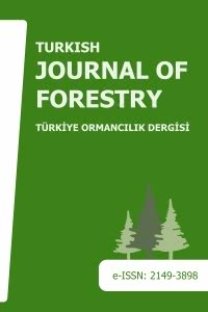Biyolojik çeşitliliği korumaya yönelik yapılan (Planlama ve koruma) çalışmalar ve Türkiye ormancılığına yansımaları
orman amenajmanı, ormancılık, sürdürülebilirlik, biyoçeşitlilik, planlama
Studies (Planning and conservation) on biodiversity and their reflections on Turkish Forestry
forest management, forestry, sustainability, biodiversity, planning,
___
Allen, R.B., Bellingham, P.J., Wiser, S.K., 2003. Developing a Forest Biodiversity Monitoring Approach For New Zealand. New Zealand Journal of Ecology 27(2):207-220.Anonim, 2005. Yenice Ormanları, WWF-Türkiye Doğal Hayatı Koruma Vakfı, http://www.wwf.org.tr/tr/ormanlar_dunya_sn_yo.asp, Erişim: 01.08.2005.
Aubry, K.B., Amaranthus, T.P., Halpern, C.B., White, J.D., Woodard, B.L., Peterson, C.E., Lagoudakis, C.A., Horton, A.J., 1999. Evaluating the Effects of Varying Levels and Patterns of Gren-Tree Retention: Experimental Design of the DEMO Study . Northw. Sci.:73:12-26.
Azofeıfa-Sanchez, G.A., Mateo-Quesada, C., Quesada-Gonzalez, P., Dayaqnandan, S., Bawas, K.S., 1999. Protected Areas and Conservation of Biodiversity in The Tropics, Consevation Biology, 13 (2): 407-411.
Başkent, E.Z., 1999. Ecosystem Management and Biodiversity, Journal of Turkish Agriculture and Forestry, number:2, s.355-363.
Başkent, E.Z., Köse, S., Kaya, Z., Altun L., Terzioğlu, S., Başkaya Ş., Eser T., 2004. Türkiye Cumhuriyeti, GEF II: Biyolojik Çeşitlilik ve Doğal Kaynak Yönetimi Projesi: Türkiye’de Biyolojik Çeşitliliğin Orman Amenajman Planlarına Entegrasyonu Strateji ve Tasarımının Geliştirilmesi, Son Rapor, 57 s.
Başkent, E.Z., Köse, S., Terzioğlu, S., Başkaya Ş., Altun L., 2005. Biyolojik Çeşitliliğin Orman Amenajman Planlarıyla Bütünleştirilmesi GEF Projesi Yansımaları-1 (Tasarım), Orman Mühendisliği Dergisi, Sayı: 4-5-6, s.31-37.
Bergeron, Y., Harvey, B., 1997. Basing Silviculture on Natural Ecosystem Dynamics: An Approximately Applied to the Southern Boreal Mixed wood Forest of Quebec, Forest Ecology and Management, 92: 235-242.
Bolen, E. G., Robinson, W.L. 1999. Wildlife Ecology & Management, Fourth Edition, Prentice Hall, Upper Saddle River, New Jersey, pp. 317-337.
Ehnström, B., 2001. Leaving Dead Wood for Insects in Boreal Forests-Suggestions for The Future, Scandinavian Journal of Forest Research Suppl 3:91-98.
Franklin, J. F. 1993. Preserving Biodiversity: Species, ecosystems, or Landscapes ? Ecological Applications, 3(2): 202-205.
Franklin, A. B., Gutierrez, R.J. 1987. Population Ecology of The Northern Spotted Owl in Northwestern California: Preliminary Results, California Department of Fish and Game, Sacramento, California.
Franklin, J.F., Berg, D.R., Thornburg, D.A., Tappeiner, J.C., 1997. Alternative Silvicultural Approaches to Timber Harvesting: Variable Retention Systems. Creating a Forestry for the 21st Century. The Science of Forest Management, pp. 111-139. Island Press, Washington.
Gökyiğit, A.N. 2002. Tema’nın Camili’de Doğal Varlıkları Koruyucu Kırsal Kalkınma Projeleri, II. Ulusal Karadeniz Ormancılık Kongresi, Bildiriler Kitabı, Cilt: 1, 15-18 Mayıs, Artvin, 328-339.
Hansson, L., 2001. Key Habitats in Swedish Management Forests, Scandinavian Journal of Forest Research Suppl 3:52-61.
Harris, L.D., Scheck, J., 1991. From Implications to Applications: The Dispersal Corridor Principle Applied to the Conservation of Biological Diversity. Nature Conservation 2: the role of Corridors, pp.189-220. Surrey Beatty and Sons, NWS, Australia.
Işik, K., Yaltirik, F., Akesen, A., 1997. Forests, Biological Diversity and The Maintenance of The Natural Heritage, Proceedings of the XI. World forestry Congress, Vol:2, s.3-28, 13-22 October, Antalya.
Kaya, Z., 2003. Biyolojik Çeşitliliğin Korunması, Türlerin İşlevleri ve Anahtar Türlerin Önemi, Orman Ve Av Dergisi, 35-42.
Kaya, Z., 2005. Biyolojik Çeşitlilik Korumanın Orman Planlama ve İşletmeciliği ile Bütünleştirilmesi, Orman ve Av Dergisi, 4-15.
Köse, S., Başkent, E.Z., Sivrikaya, F., Yolasiğmaz, H.A. 2002. Karadeniz’de Orman Fonksiyonlarının Belirlenmesi ve Örnek Uygulamalar, II. Ulusal Karadeniz Ormancılık Kongresi, Bildiriler Kitabı, Cilt: 1, 15-18 Mayıs, Artvin, 78-87.
Larsson, S., Danell, K., 2001. Science and Mangement of Boreal Forest Biodiversity, ScandinavianJournal of Forest Research Supp 3: 5-9.
Masozera, M.K., Alavalapati, J.R.R., 2004. Forest Dependency and Its Implications for ProtectedAreas Management: Acase Study Form the Nyungwe Forest Reserve, Rwanda, Scandinavian Journal of Forest Research, Suppl 4:85-92.
Negi, S.S., Stimm, B., 1997. Almanya ve Hindistan’da orman Biyoçeşitliliğinin Korunması: Bir Karşılaştırmalı Analiz, XI. Dünya Ormancılık Kongresi Bildirileri, Cilt:2, s.73-80, 13-22 Ekim, Antalya.
Niemela, J., Larsson, S., Simberloff, D., 2001. Concluding Remarks: Finding Ways to Integrate Timber Production and Biodiversity in Fennoscandian Forestry, Scandinavian Journal of Forest Research Suppl., 3:119-123.
Nilsson, S.G., Hedin, J., Niklasson, M., 2001. Biodiversity and Its Assessment in Boreal and Nomoral Forests, Scandinavian Journal of Forest Research Suppl 3: 10-26.
North, M., Chen, J., Smith, G., Krakowiak, L., Franklin, J., 1996. Initial Responce of Understory Plant Diversity and Overstory Tree Diameter Growth to a GTR Harverst. Northw. Sci. 70:24-35.
Noss, R.F., 1999. Assessing and Monitoring Forest Biodiversity: A Suggested Franework and Indicators, Forest Ecology and Management, 115:135-146.
Putz, F.E., Blate, G.M., Redford, K.H., Fimbel, R., Robinson, J., 2001. Tropical Forest Management and Conservation of Biodiversity: an Overview, Conservation Biology, 15 (1): 7-20.
Puumalainen, J., Kennedy, P., Folving, S., 2003. Monitoring Foresty Biodiversity: a European Perspective with Reference to Teprate and Boreal Forest Zone, Journal of Environmental Management, 67: 5-14.
Raivio, S., Normark, E., Pettersson, B, Salpakivi-Salomaa, P., 2001. Science and The Management of Boreal Forest Biodiversity-Forest Industries’ Views, Scandinavian Journal of Forest Research Suppl. 3: 99-104.
Siitonen, J., Martikainen, P., 1994. Occurrence of Rare and Threatened İnsects Living on Decaying Populus tremula: a Comparison Between Finnish and Russian Karelia, Scandinavian Journal of Forest Research, 9:185-191.
Vanha-Majamaa,I., Jalonen, J., 2001. Green Tree Retention in Fennoscandian Forestry, Scandinavian Journal of Forest Research Suppl 3:79-90.
- ISSN: 1302-7085
- Yayın Aralığı: Yılda 2 Sayı
- Başlangıç: 2000
Bazı ahlat (Pyrus L.) türlerinin tohum özellikleri ve çimlendirme olanakları üzerine araştırmalar
H. Cemal GÜLTEKİN, Abdullah Gezer, CENGİZ YÜCEDAĞ
Kalkınma ve kırsal kalkınma: Temel kavramlar ve tanımlar
Gökhan ABAY, Güray UYAR, BARBAROS ÇETİN, TAMER KEÇELİ
Ormancılıkta üretim işlerinde çalışma koşulları ve iş kazaları üzerine bir araştırma
Kimyasal termomekanik hamur yöntemi
Orman ürünleri endüstrisinde benzetim destekli çalışmalar ve bir örnek uygulama
ABDULLAH SÜTÇÜ, Ercan TANRITANIR, Abdullah ERDOĞLU, HALİL İBRAHİM KORUCA
AŞKIN GÖKTÜRK, Zeki YAHYAOĞLU, ZAFER ÖLMEZ, FATİH TEMEL
Kent ormancılığı kavramı ve Isparta kent içi ölçeğinde irdelenmesi
Amerikan beyaz kelebeği (Hyphantria cunea (Dry.)) üzerine biyolojik ve morfolojik araştırmalar
